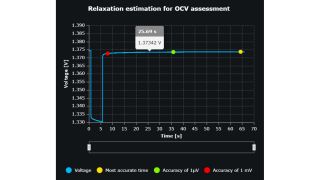Rohde & Schwarz solution
The Rohde & Schwarz tool makes development work easier. The R&S®NGM-K106/NGU-K106 option for R&S®NGM200/NGU201 power supplies lets developers simulate battery behavior under different conditions and requirements, allowing real batteries to be used early in the R&D cycle.
The R&S®NGM200/NGU201 uses models with dynamic internal resistance that change with the state of charge, simulating batteries. The load step method can derive the parameters necessary to create a battery model file for the R&S®NGM200/NGU201.
A battery model file can easily be created with a spreadsheet, a text editor or directly in the battery model editor on the R&S®NGM200/NGU201. While a battery model is fairly simple and proper use requires advanced expertise for highly accurate emulations of Ni-MH cells, for example.
Battery test setup
The R&S®NGM200/NGU201 has sample battery model files for lead acid, lithium-ion, nickel-cadmium and nickel-metal hydride batteries.
The battery modeling tool from Rohde & Schwarz greatly simplifies the parameterization needed to simulate and model batteries. R&S®NGM200/NGU201 power supply software users no longer have to write their own scripts for controls, measurements, data processing, data displays and model calculations.












